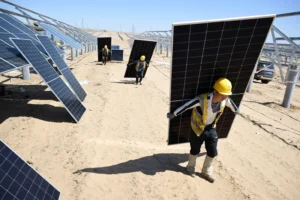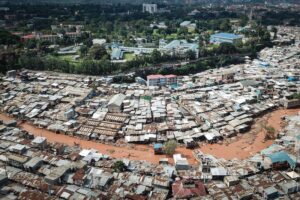Existing green growth policies are leading nowhere fast, so scientists say it’s worth exploring alternatives like degrowth to stay within planetary boundaries.
With Earth’s average annual temperature speeding toward 1.5 degrees Celsius faster than expected and global climate policy on a treadmill, an increasing number of researchers say it’s time to consider a “restorative pathway” to avoid the worst ecological and social outcomes of global warming.
New Research Explores a Restorative Climate Path for the Earth
Climate Change
Guest post: What an ‘ambitious’ 2035 electricity target looks like for China
China’s power sector is both the world’s largest emitter and the largest source of clean-energy growth, making it essential to global climate efforts.
This means it will be a key part of China’s next nationally determined contribution (NDC) – its climate pledge under the Paris Agreement for 2035 – which all countries are expected to publish by this year.
Yet, at the same time, Chinese policymakers are grappling with perceived tensions between ensuring a reliable energy supply amid uncertain demand growth and future cost trajectories, which have the potential to weigh down climate ambition.
In our new study, co-authored with experts from Tsinghua University and published in Cell Reports Sustainability, we model pathways for China’s power system up to 2035 that are consistent with its wider climate goals, incorporating a wide range of scenarios and uncertainties currently being debated in the country.
We find that China would need to deploy 2,350-2,780 gigawatts (GW) of wind and solar by 2030 and 2,910-3,800GW by 2035 – roughly double current levels – to be consistent with a target of limiting the rise in global temperatures to 2C this century.
Furthermore, ensuring that the share of wind and solar generation reaches around 40% by 2030 and 50% by 2035 would set the power sector up for the longer-term transition to carbon neutrality by 2060.
Electricity generation from non-fossil fuels more broadly would reach around 50% by 2030 and more than 70% by 2035.
China’s climate ambitions
China’s “dual-carbon” goals, announced in 2020, aim to peak carbon emissions by 2030 and reach carbon neutrality by 2060. The country has already surpassed its 2030 renewable deployment target – 1,200GW of wind and solar – six years ahead of schedule, due to record-breaking annual additions of around 300GW of new capacity for two years in a row.
However, new coal-power developments and rapid growth in electricity demand pose a threat to meeting China’s other targets, such as emissions intensity and share of non-fossil fuel in the energy mix.
China began building nearly 95GW of new coal capacity in 2024, representing 93% of the world’s new coal capacity under construction.
If completed, China’s coal fleet – already the largest in the world – would expand to an installed capacity of 1,190GW.
This resurgence stems in large part from concerns surrounding energy security. China faced unprecedented power shortages in 2021 and 2022, while annual electricity demand has recently reached 10 petawatt-hours (PWh, or 10,000 terawatt hours) – a level that most studies predicted would not be reached until 2030.
This keeps the door open to continued growth in China’s electricity generation and emissions from coal, unless the expansion of clean energy is able to keep pace.
Setting the renewable energy pace
Our research looks at the rate of growth from clean energy that would be required to not only meet China’s rapidly rising demand for electricity, but also to push down its coal generation and squeeze emissions from the power sector.
We simulate a range of system “baselines” for 2030 and “scenarios” for 2035, under varying assumptions about electricity demand growth, carbon emissions limits, renewable energy costs and meteorological conditions.
The model includes detailed representations of where renewable energy capacity could be built and how the power sector could be operated efficiently.
It evaluates wind and solar resources and deployment potential at a level that is detailed enough to help capture regional differences and localised impacts, such as land use, socio-economic benefits and infrastructure needs.
The results are organised into 15 scenarios, categorised into three main groups: moderate growth in electricity demand (group A); rapid electrification (group B); and ambitious decarbonisation (group C).
The modelling is based around two different scenarios for China that are compatible with a global limit of 2C warming this century.
The basic 2C trajectory would see China’s power-sector emissions fall to 36% below 2024 levels by 2035, whereas the more ambitious 2C trajectory has a 42% decline.
The chart below shows recent electricity demand (left) and the carbon dioxide (CO2) emissions of China’s power sector (right), as well as how these might evolve under the different scenarios modelled for the paper.
The modelling accounts for recent trends suggesting that China’s electricity demand could reach 13.5PWh by 2035 (groups A and C). However, accommodating faster demand growth under a rapid electrification scenario (group B) would require China to deploy low-carbon energy even more rapidly, if it is to maintain pace with climate targets.
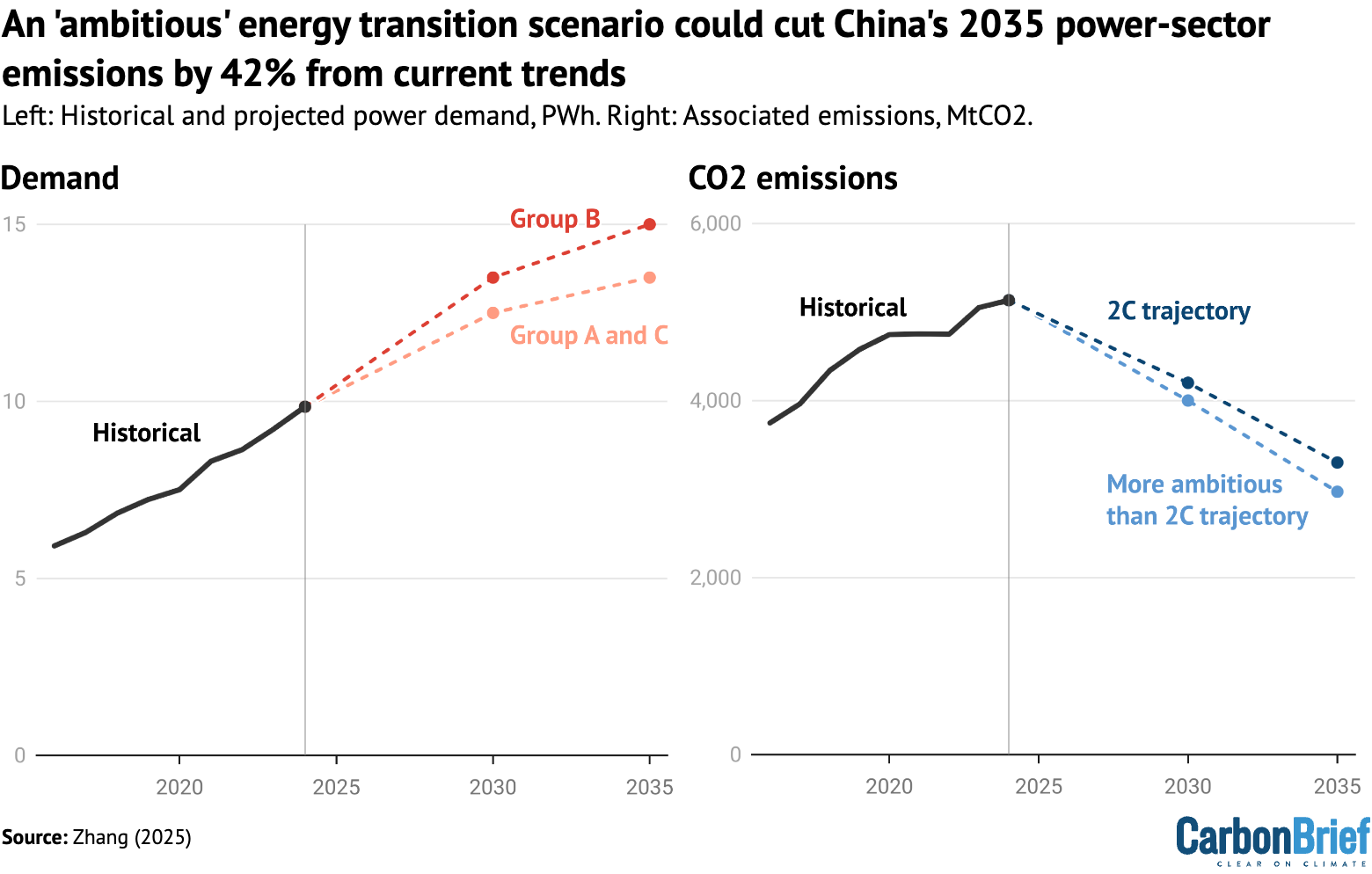
The modelling shows that wind and solar energy would need to supply around 40% of China’s electricity by 2030, if the country aims to remain on track for 2C of global warming. Solar and wind power generation would need to then rise to 50% by 2035 – up from 17.9% in 2024.
This growth would substantially reduce the system’s reliance on coal and other fossil fuels, which would decrease to 35% of generation in 2030 and 25% in 2035.
The more ambitious scenario, which targets limiting global warming since the pre-industrial period to between 1.5C and 2C, would lead to even higher wind and solar generation shares of 44% by 2030 and 54% by 2035.
Under the different scenarios, China’s wind and solar capacity would rise from around 1,700GW today to 2,350-2,780GW by 2030 and 2,910-3,800GW by 2035. Meeting this level of renewable deployment would require annual additions of 120-220GW.
Recent wind and solar additions have already exceeded this pace, but challenges with grid integration and supporting infrastructure could, nevertheless, slow future large-scale buildouts.
According to industry reports, 6.8% of wind and 6.1% of solar power generation were “curtailed” in the first four months of 2025, meaning the output could not be accommodated by the electricity grid and was wasted.
At the provincial level, wind and solar curtailment rates exceeded 10% in renewable-rich regions, such as Xinjiang, Gansu and Qinghai. To achieve the cost-efficient pathways modeled here, curtailment rates fall to 3-6%.
To achieve this level of integration, energy storage and transmission infrastructure will be necessary to shift renewable generation towards when and where it is needed.
Battery and grid capacity would need to rise by 6% and 5% per year from current levels out to 2035, respectively, in order to better integrate renewables into the grid.
Boosting wind and solar generation share
In order to explore the implications of uncertainty on China’s power system in 2030, the modelling includes three core scenarios (groups A-C).
Within these core groups, the modelling looks at the impact of further uncertainties on system outcomes by 2035, labelled A1, A2 and so on. This results in a “decision-tree” structure that outlines a range of possible futures.
The lines on the chart below show the share of China’s electricity that would be generated by wind and solar by 2030 and 2035, under each of these different futures. The coloured columns show the share of electricity generated by wind (red), solar (yellow), hydro (blue), nuclear (pink) and biomass (grey) in one specific scenario, namely, the “reference” case for renewable costs with moderate demand growth (A1).
The bands in the right-hand margin indicate the ranges of the 2035 results under all of the future scenarios, depending on variables such as the cost of renewables or batteries (cases two to four) and a larger rise in demand (case five).
At a minimum, for each of the 2C-compatible scenarios, wind and solar would take up around 50% of total generation by 2035.
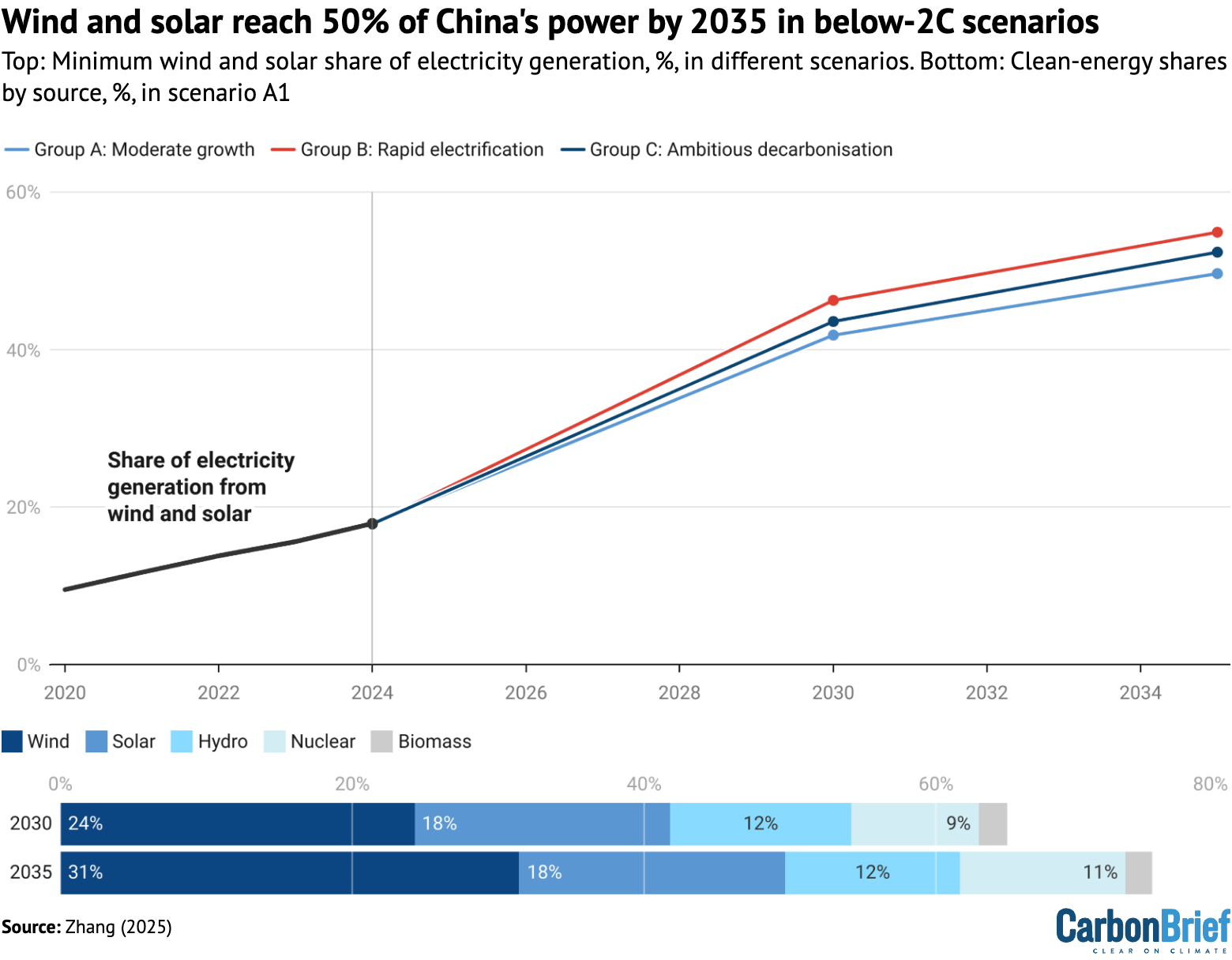
Another consistent result across all scenarios is the need for more transmission capacity to shift generation from renewable-rich regions to those with high demand for power. By 2030, at least 225GW of new inter-provincial transmission capacity would be required, further enhancing electricity trading and grid reliability.
China is already expanding its “ultra-high-voltage” (UHV) transmission network at breakneck speed. As of the end of 2024, there were 42 UHV projects in operation, with a combined capacity exceeding 300GW.
Another assumption in the modelling is that electricity can flow freely and efficiently across regions, up to the transmission capacity limits. But, in reality, institutional and regulatory barriers complicate regional electricity trading.
China plans to establish a national unified power market by 2029. As such, deregulating the power sector is seen as an essential measure to enhance the power system’s operational efficiency and facilitate renewable energy integration.
Looking ahead to the NDC and beyond
Many experts have weighed in on China’s NDC target-setting, largely focusing on economy-wide emissions targets and non-CO2 greenhouse gases.
While these are indeed important elements of China’s next international climate pledge, our study seeks to identify robust power-sector targets that could support the country’s overall ambition and provide credible signals to energy planners.
Due to the rapidly evolving economic and geopolitical situation, there are good reasons to expect that China’s topline emissions number may be underwhelming.
On the other hand, there is an opportunity to emphasise and expand ambition within the power sector through additional sectoral targets. This would put a focus on quantifiable metrics that can guide investments and planning by state-owned enterprises and local governments.
While China has previously set a target for the absolute capacity of wind and solar, a goal for the share of electricity generation from these technologies, or for clean energy more broadly, would set a narrower range for future emissions from the power sector.
Given current uncertainties around the pace of power demand growth, for example, a target for clean energy share might provide greater confidence to policymakers than a capacity target alone.
Regardless of what targets are set, achieving the growth of clean energy modelled in our study would support China’s long-term climate commitments and demonstrate the nation’s intent to be a clean-energy powerhouse.
The post Guest post: What an ‘ambitious’ 2035 electricity target looks like for China appeared first on Carbon Brief.
Guest post: What an ‘ambitious’ 2035 electricity target looks like for China
Climate Change
Revealed: ‘Cali Fund’ for nature still empty as emails show industry hesitation
A major fund for biodiversity remains starved of resources more than five months after its launch – with no money yet put forward by the large companies who could contribute.
The “landmark” Cali Fund – which could generate billions of pounds each year – was created under the UN Convention on Biological Diversity (CBD) at the COP16 nature negotiations in Cali, Colombia last autumn.
Countries agreed that certain companies “should” pay into the fund, but this is not legally binding and donations are, ultimately, voluntary.
The fund is designed to be a way for companies who rely on nature’s genetic resources to share some of their earnings with the developing, biodiverse countries where many of the original resources are found.
Companies use genetic data from these materials to develop products, such as vaccines and skin cream.
Emails released to Carbon Brief under the UK Freedom of Information (FOI) Act show that companies were contacted with opportunities to be involved in the Cali Fund before its launch in February 2025.
Pharmaceutical giant AstraZeneca did not take up an offer from a UK government department to be a “frontrunner” in committing to donate to the fund, the emails show.
GSK, another major company in the sector, also did not confirm its position.
These are the UK’s two largest pharmaceutical companies and they could each potentially contribute tens of millions of pounds to the fund, based on current guidelines.
Earlier this year, a spokesperson for the CBD said that the first contributions to the Cali Fund could be announced in spring.
One US biotechnology company has pledged to contribute to the fund in the future, but, for now, the fund remains empty.
Company hesitancy could be “driven by industry bodies” who “don’t want unhappy precedents to be set” on the level of funding, a researcher who was involved in the fund negotiations tells Carbon Brief.
Lack of funds
Companies all around the world use genetic materials from plants, animals, bacteria and fungi to develop their products.
There are existing rules in place to secure consent and compensation, if companies or researchers physically travel to a country to gather these materials.
But, currently, much of this information is available in online databases – with few rules in place around the requirements needed for access. This genetic data is known as digital sequence information (DSI).
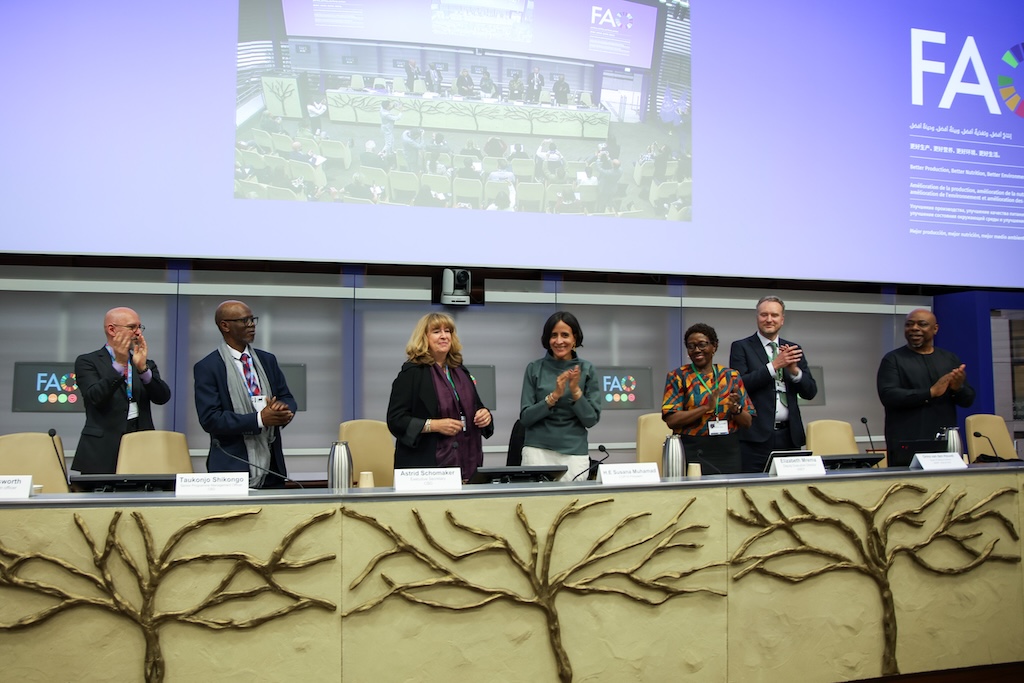
In an effort to close the loophole, almost every country in the world agreed in 2024 to set up the Cali Fund.
The agreement outlines that large companies in sectors including pharmaceutical, cosmetic, biotechnology, agribusiness and technology “should” contribute to the fund to share back a cut of the money they earn from the use of these materials. (See: Carbon Brief’s infographic on DSI.)
However, these contributions are voluntary. Many African and Latin American countries sought a legally binding mechanism around this issue at COP16, but this did not happen.
The fund officially opened at the resumed COP16 negotiations in Rome in February 2025.
With the fund still empty more than five months later, a spokesperson for the CBD secretariat tells Carbon Brief that a US-based biotechnology firm, Ginkgo Bioworks, is the first to “indicat[e] its intention to contribute”.
The CBD, also acting as the interim secretariat for the new fund, “continue[s] to engage with business associations to raise awareness and secure funding”, the spokesperson says.
They add that a decision-making body and a steering committee have been set up.

The CBD received “positive feedback and engagement” from companies about the fund, the UN biodiversity chief Astrid Schomaker said in a February press conference. She added that donations were expected “very soon”, but not in “massive numbers”.
Carbon Brief contacted Ginkgo Bioworks for comment, but did not receive a response in time for publication.
‘Frontrunner’ contributors
Through an FOI request, Carbon Brief received email correspondence between the UK Department for Environment, Food & Rural Affairs (Defra), major pharmaceutical companies AstraZeneca and GSK, and trade group the Association of the British Pharmaceutical Industry (ABPI) between August 2024 and April 2025. (Carbon Brief has uploaded the FOI documents it received to a Google Drive folder.)
A representative from Defra told AstraZeneca in December 2024 that they were contacting a “select number of companies that will likely be frontrunners with the Cali Fund and make contributions – leading the way for others to follow suit”.
The Defra employee said that they had received “some positive signals from these companies” and asked if AstraZeneca was interested in “demonstrating commitment in this start-up phase of the fund”. This email said:
“I hope this finds you well – and thanks for joining various calls over the last few weeks on DSI, it’s great to have you involved. I know that AZ have been really forward leaning on ABS issues in the past (including under your leadership) and now that we have the Cali Fund for benefit sharing from the use of DSI, I wondered if we might pick up the conversation on any role AZ might be able to take as an early mover in the ABS world?
“We are beginning to have conversations with a select number of companies that will likely be frontrunners with the Cali Fund, and make contributions – leading the way for others to follow suit – and we have had some positive signals. Do you think there might be any interest from AZ in demonstrating commitment in this start-up phase of the Fund? If it would be helpful to have a conversation to chat through, please do let me know and I’d be super happy to set something up.”
The AstraZeneca representative responded to say the company was “in the process of conducting an assessment to define our position” on the fund and that they would “welcome a conversation” when this concluded.
A Defra official contacted the company again in early January to say the government was preparing meetings between a member of the CBD secretariat and several businesses “that have shown some interest in leading others by making the first contributions to the fund”.
They asked if AstraZeneca was interested in attending this meeting. The company declined, but said it would be interested in future discussions.
An AstraZeneca spokesperson declined to respond to Carbon Brief’s questions, but Carbon Brief understands that the company is still reviewing its position on the fund.

Similar exchanges took place between representatives from Defra and GSK ahead of the Cali Fund launch.
GSK was invited to the same January meetings, but the company said nobody was available to attend. A Defra official contacted GSK in February to update on progress with the fund, outlining that it would be launched in Rome, “accompanied by a platform for announcements and press coverage”.
The Defra official asked GSK to let them know “if you think there might be any opportunities for GSK – we would obviously love to add your voice to the positive coverage”. The email read:
“As a broader update, we are still expecting the Fund to formally launch in Rome at COP16.2, and that will be accompanied by a platform for announcements and press coverage. We are also working with another CBD Party to explore the option of putting on some kind of reception for those businesses that are leading the way together.
“Please do let me know if you think there might be any opportunities for GSK – we would obviously love to add your voice to the positive coverage!”
They also asked if GSK would like to see a draft version of a press release from the CBD about the launch of the Cali Fund, along with other businesses “that are interested in being part of the launch”.
(The Cali Fund launch press release did not contain any quotes or donation announcements from companies.)
GSK said that it was “awaiting further clarification on a number of key elements” before making a decision on the Cali Fund and would respond “in due course”.
The company “support[s] the intent” behind the fund, a spokesperson tells Carbon Brief, adding:
“We’ll make a decision regarding voluntary contributions when more information becomes available about how the Cali Fund sits alongside other multilateral mechanisms.
“GSK was one of the first companies to publish a nature strategy and we continue to work on delivering our plan to address our nature impacts and invest in nature protection and restoration.”
A Defra spokesperson tells Carbon Brief:
“Nature underpins everything and those who profit from the use of genetic data should pay nature back. The Cali Fund provides the route for companies to do that.
“The government is committed to continuing to engage constructively with industry to drive contributions and champion the fund to protect nature and sustain innovation.”
The UK and Chile recently launched the “friends of the Cali Fund” group, which “brings together” governments and businesses to “champion” benefits sharing, a UK government statement said. Norway, Germany, the Netherlands and Colombia have also joined this group.
UK companies could contribute £64m
Contributions to the Cali Fund are voluntary. They will depend on whether companies that rely on the use of genetic data will then admit to using genetic materials and decide to pay into the fund.
The agreement behind the fund, which is not legally binding, outlined that companies “should” contribute 1% of their profits, or 0.1% of their revenue. These are an “indicative rate”.
Words that are more binding, such as “will” and “shall”, were included in non-paper negotiation texts during the talks. But the final agreement referred to a fund that companies “should” pay into, which was criticised by some experts at the time.
At least half of the money raised will go towards meeting the “self-identified” needs of Indigenous communities in developing countries, particularly women and young people.
The overall fund could generate between $1bn and $10bn each year, according to a 2024 analysis requested by the CBD.

The cache of information released under FOI to Carbon Brief also includes a report on the impacts of a mandatory payment for using digital sequence information, which was prepared for Defra by consultancy company ICF in July 2024.
It estimated that a mandatory 1% levy on the profits of large UK companies “who are considered DSI-dependent” could generate nearly £64m ($85m) for the fund.
The report compared three different benefit-sharing mechanisms around genetic data: a mandatory levy on UK profits/revenues; a flat fee; or a subscription fee.
All options would negatively impact on “innovation” to varying degrees, the report said, but a mandatory levy on profits was found to have the “least negative impact on competition and innovation”.
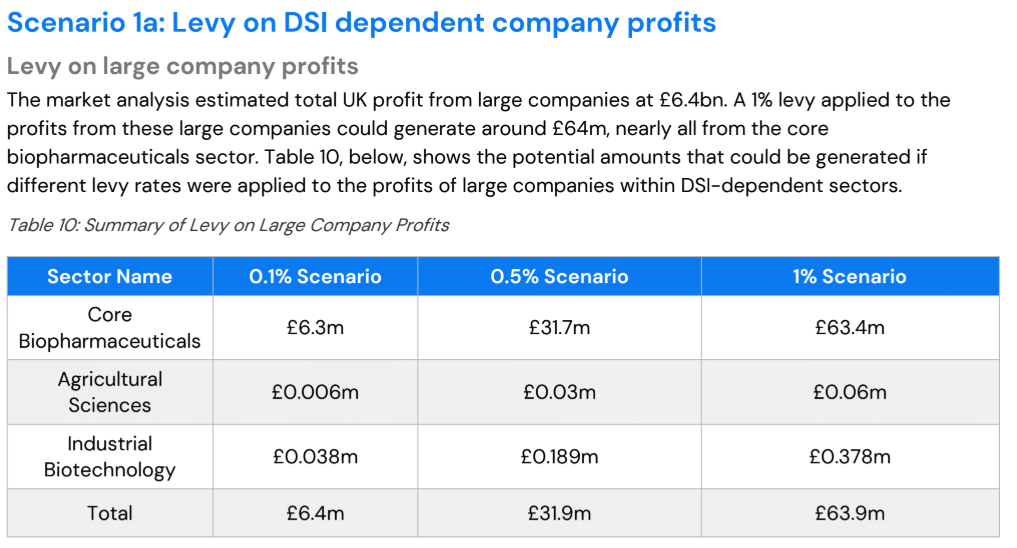
During the Cali Fund negotiations last October, the Guardian reported that AstraZeneca “said it may cut jobs” in the UK, if such a levy was introduced. An AstraZeneca spokesperson denied the comments, the newspaper said.
Based on the “indicative” contribution rates of 1% of profits or 0.1% of revenue, Carbon Brief estimates that AstraZeneca could potentially contribute as much as £41-66m ($54-88m) and GSK £31-35m ($41-46m) each year to the fund.
AstraZeneca reported revenue of £41bn ($54bn) and £6.6bn ($8.7bn) in profit before tax in 2024. GSK’s revenue that year was around £31bn ($40bn) and its pre-tax profit was £3.5bn ($4.6bn).
Lobbying concerns
At COP16, many observers were concerned about industry lobbying around digital sequence information.
DeSmog analysis of COP16 attendees highlighted the presence of big pharmaceutical companies, powerful industry groups and agribusiness at the talks.
The International Federation of Pharmaceutical Manufacturers and Associations (IFPMA), a global pharmaceutical trade group, said it had “serious concerns” about proposals around the fund at the start of COP16. The group said it would result in “regulatory and financial barriers that would stifle innovation, delay R&D [research and development] and complicate compliance”.
The emails obtained by Carbon Brief show that, in August 2024, a GSK representative told Defra that the company believed proposals for a “simplistic payment mechanism based on revenues would be disproportionate and could hinder the development of new medicines and vaccines”. This email said:
“You were asking for views on the call, so I also wanted to take the opportunity to share GSK’s perspective at this time. We are supportive of a practical and fair multilateral mechanism for benefit-sharing from the use of digital sequence information on genetic resources. The criteria for this mechanism listed in decision 15/9 are particularly important, specifically the fact that it must not hinder research and innovation.
“We are concerned that the current proposals for a simplistic payment mechanism based on revenues would be disproportionate and could hinder the development of new medicines and vaccines. We would support the consideration of other models, for example a subscription model whereby organisations that access open source DSI databases make a contribution to the global fund.
“This would have the benefit of broadening the base of contributors. Tiers could be established based on size of organisation, so that the contributions were proportionate and fair.”
The FOI release also shows that ABPI chief executive, Dr Richard Torbett, wrote a letter to UK nature minister Mary Creagh on 17 October 2024, a few days before the COP16 summit began.
He “urge[d]” the government to not agree on the details of a fund “until more work has been conducted to understand the implications of proposals”.
Torbett said that, if this was not possible, the ABPI wanted the government to support an option put forward by Japan and South Korea to introduce a voluntary funding mechanism.
Hesitancy potentially ‘driven by industry bodies’
In a statement after COP16, the IFPMA’s director general, Dr David Reddy, said the decision creating the Cali Fund “does not get the balance right between the intended benefits of such a mechanism and the significant costs to society and science that it has the potential to create”.
The FOI release obtained by Carbon Brief includes a 20 March 2025 document from the ABPI discussing possible future changes to the fund.
The group said the fund “contains and omits several features which make it unlikely to attract significant contributors”. The ABPI “cannot over-emphasise the importance” of the fund being voluntary, the document said, with companies “free to decide” if and how much they want to contribute.
The ABPI urged the UK to discourage any country-level implementation of the COP16 digital sequence information agreement, arguing that “conflicting” action on a national, rather than global, level would “reduce the (already weak) incentives to contribute to the Cali Fund”.
The ABPI also criticised the agreed 0.1% and 1% contribution rates for companies, saying they are “regarded by industries generally as being unrealistic and likely to impact innovation”.
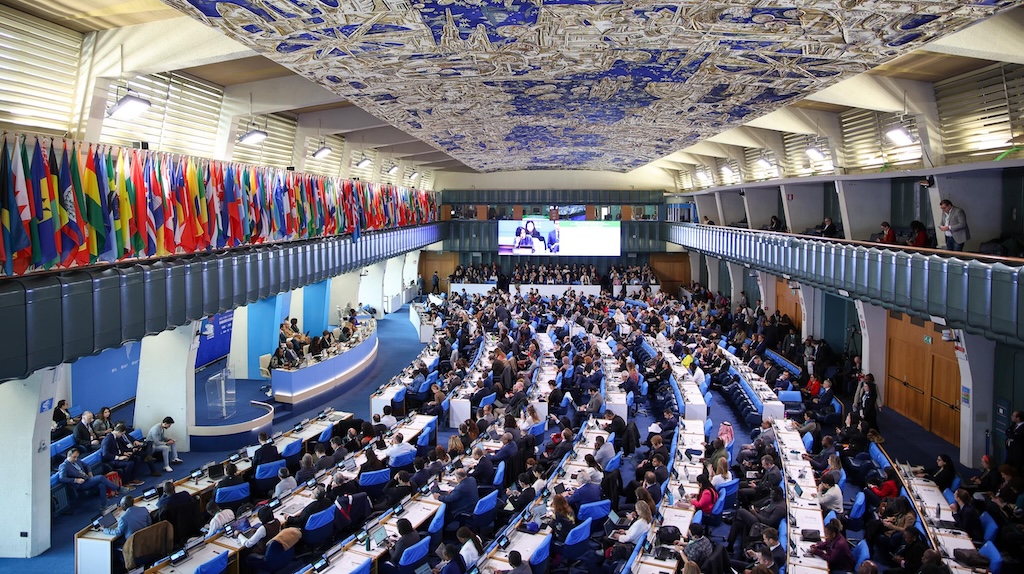
The ABPI declined to respond to Carbon Brief’s questions and referred Carbon Brief to the global trade group, the IFPMA. A spokesperson for the IFPMA also declined to respond to questions and pointed towards the company’s public statements on the issue.
Dr Siva Thambisetty, an associate professor of law at the London School of Economics and Political Science and project lead on an ocean biodiversity research group, believes the first contribution to the fund is a “prize that’s just waiting to be won”. She tells Carbon Brief:
“It would be an absolute coup for a responsible DSI company to be the first to make a contribution to the Cali Fund. Investors should be very interested in that company, for instance.
“We’ve got to move to a biodiversity market where investors are asking whether companies they invest in are contributing to remedy and repair at a global level through appropriate monetary benefit sharing.”
Thambisetty believes that this is “low-hanging fruit”, but acknowledges that companies have varying opinions on the fund and that the “majority might be unsure how to deal with this”. She adds:
“I think the hesitancy is mostly being driven by industry bodies because they don’t want unhappy precedents to be set. There is a collective action problem and the first company to break cover will be sending a signal that will be received differently by different people.”
The post Revealed: ‘Cali Fund’ for nature still empty as emails show industry hesitation appeared first on Carbon Brief.
Revealed: ‘Cali Fund’ for nature still empty as emails show industry hesitation
Climate Change
Virginia’s Democratic Gubernatorial Candidate Embraces Renewables, Natural Gas and Community Planning for Data Centers
Former Congresswoman Abigail Spanberger strikes a different tone than the current Republican administration and wants to expand energy possibilities.
Former Congresswoman Abigail Spanberger is campaigning for Virginia’s governor’s race on an energy platform that supports robust renewable development and continued use, as needed, of natural gas. The former Democratic lawmaker also aims to make energy-reliant data centers pay for upgrades to the electrical grid.
-
Climate Change2 years ago
Spanish-language misinformation on renewable energy spreads online, report shows
-
Climate Change Videos2 years ago
The toxic gas flares fuelling Nigeria’s climate change – BBC News
-

 Greenhouse Gases1 year ago
Greenhouse Gases1 year ago嘉宾来稿:满足中国增长的用电需求 光伏加储能“比新建煤电更实惠”
-

 Climate Change1 year ago
Climate Change1 year ago嘉宾来稿:满足中国增长的用电需求 光伏加储能“比新建煤电更实惠”
-

 Carbon Footprint1 year ago
Carbon Footprint1 year agoUS SEC’s Climate Disclosure Rules Spur Renewed Interest in Carbon Credits
-
Climate Change2 years ago
Why airlines are perfect targets for anti-greenwashing legal action
-
Climate Change Videos2 years ago
The toxic gas flares fuelling Nigeria’s climate change – BBC News
-
Climate Change2 years ago
Some firms unaware of England’s new single-use plastic ban















